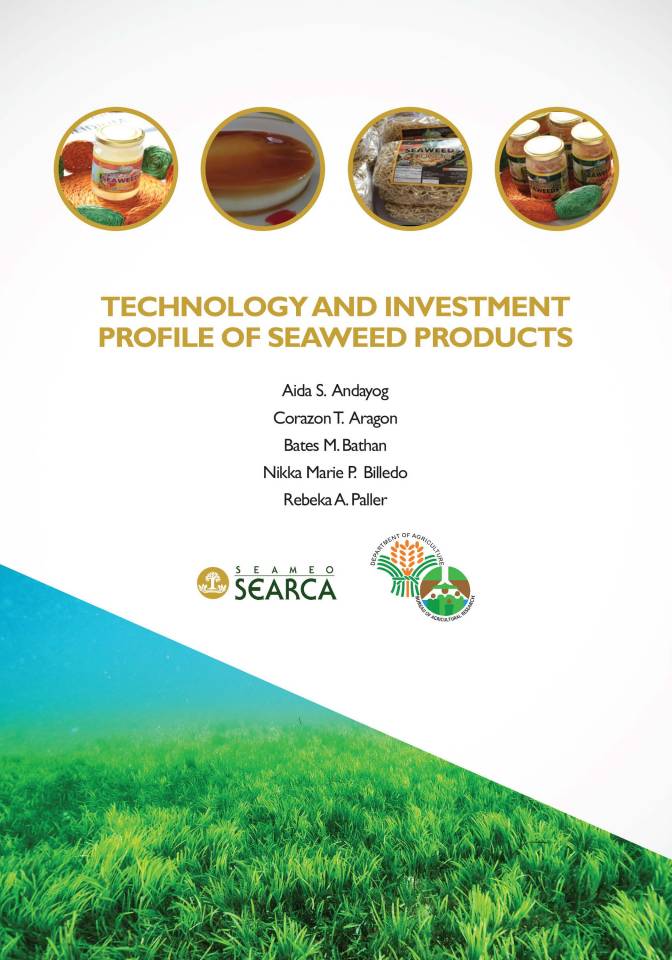Seaweed, known for its many uses, is a versatile commodity that has applications which extend from food to industrial uses. It is a good emulsifier with good water holding capacity, and excellent binding properties. With these qualities, the opportunities for value-adding food technology for seaweed are enormous.
 The Bicol Region in the Philippines, specifically the province of Sorsogon, is known as one of the country's major producers of seaweeds. In fact, the commodity has been a promising source of income to many in the fisheries sector. The Bureau of Fisheries and Aquatic Resources- Regional Fisheries Research and Development Center (BFAR-RFRDC) has so far developed at least 20 seaweed products. Some of these seaweed processed products still needed some improvements in term of texture, palatability, color, odor, fortification of vitamins and minerals, and in terms of product labeling and packaging designs before they could be introduced in the market. For this reason, the BFAR-RFRDC implemented the DA-BAR funded project titled "Technology Enhancement and Utilization of Value-Added and Fishery Products in the Bicol Region."
The Bicol Region in the Philippines, specifically the province of Sorsogon, is known as one of the country's major producers of seaweeds. In fact, the commodity has been a promising source of income to many in the fisheries sector. The Bureau of Fisheries and Aquatic Resources- Regional Fisheries Research and Development Center (BFAR-RFRDC) has so far developed at least 20 seaweed products. Some of these seaweed processed products still needed some improvements in term of texture, palatability, color, odor, fortification of vitamins and minerals, and in terms of product labeling and packaging designs before they could be introduced in the market. For this reason, the BFAR-RFRDC implemented the DA-BAR funded project titled "Technology Enhancement and Utilization of Value-Added and Fishery Products in the Bicol Region."
This project and its products are the subject of the of the study conducted and published by SEARCA titled "Technology and Investment Profile of Seaweed Products" to further assess its commercialization potential through a financial viability analysis. Ms. Aida Andayog, BFAR-RFRDC manager, implemented the technology enhancement project in Bicol and also co-authored in the SEARCA study.
The products highlighted in the study include nata de seaweed, seaweed pickles, seaweed leche flan, and seaweed noodles. Nata de seaweed is a cholesterol free, translucent and jelly-like food made from pure seaweed extract which is usually served for dessert and in fruit salads. Seaweed pickles is a mixture of seaweeds, spices, and vegetable soaked in a pickling solution, best served as a side dish in a variety of meals. Seaweed leche flan, on the other hand, is a popular Filipino dessert made of caramel custard from seaweed puree, condensed milk, and egg yolk. Lastly, seaweed noodles, used in many pancit recipes, is made from all-purpose flour and seaweed puree.
The study showed how seaweed is not only a versatile commodity but is also a rich source of vitamins and essential minerals such as magnesium, calcium, potassium, selenium, zinc, iodine, and iron. Other benefits of seaweeds include its ability to manage obesity, diabetes, influenza, improve digestive health, dental health, cardiovascular health, and maintaining heathy skin and hair. It helps in detoxification and with thyroid function since it is rich in iodine and tyrosine.
The study also cited methods on improving the products' marketability. Specifically, market research was done to determine the products' acceptability and to promote the improved products through product display during trade fairs and through the distribution of flyers, brochures, pamphlets, and e-copies of recipes of the seaweed products to create consumer awareness of these products. The study specified that its target market are restaurants, eateries, sari-sari stores, grocery stores, supermarkets, and hotels.
Aside from the technical and market aspect of the technology that were presented in the study, it also included the financial viability analysis of each product. It assessed its investment feasibility for interested technology investors. To determine the financial feasibility of the products, the authors used cash flow analysis with the following tools: net present value, benefit-cost ratio, and financial internal rate return. Results showed that all seaweed products have met the parameters for each tool to be identified as a financially viable investment project. The authors showed that the pure nata de seaweed, seaweed pickles, seaweed leche flan, and seaweed noodles have promising investment potential given the set assumptions. This indicates that it is a feasible investment for interested investors.
SEARCA, through its core program on Emerging for Innovation for Growth, is now actively working to support and promote technology-based innovations among local enterprises in the Philippines as outlined in its 11th Five-Year Plan which is intent on Accelerating Transformation Through Agricultural Innovation (ATTAIN). For a more detailed discussion on the SEARCA-published monograph on technology of seaweed products under the DA-BAR-funded project "Financial Viability and Profitability Analysis of Agricultural Technologies and Enterprises," it may be downloaded for free from the SEARCA website: https://www.searca.org/pubs/monographs?pid=482